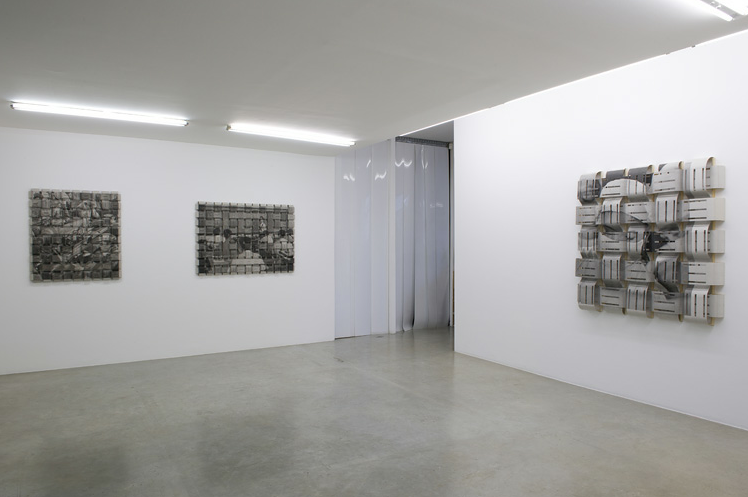For his second exhibition at Air de Paris, Thomas Bayrle presented three series of works from different periods of his career. Following a logic of inverse chronology, the exhibition proposed a progressive dive into the history of Bayrle’s work, from his most recent grey cardboards to his more colorful paintings, resulting in a panorama of the meticulous aesthetic research that crosses the decades of Bayrle’s artistic practice. Crosses, or one should rather say, criss-crosses, for Bayrle’s approach is criss-crossed with one essential thread, namely his taste for interlacing, networks, and patterns directly inherited from his craftsman’s know-how: as a young employee of a weaving factory, he learned what would later become his trademark visual code delineating individual and collective experience.
The first pieces encountered were the loosely intertwined cardboard strips silkscreened with black-and-white photographs from iconographic propaganda material from Mao-era China. The pieces Workers (Sign for Earth) (2005), School (Sign for Container) (2005), and Barefoot Doctor (2004) presented three topical symbols of bygone communist societal ideals. Mountain Climber (Sign for Sun) (2005) took a more romantic turn on national glorification, depicting a high mountain landscape sprinkled with adventurous climbers.
Although the political intentionality of such images can be easily deciphered, Bayrle’s approach renews the critical gaze by imposing a distance of a more spatial nature. The actual iconographic content of these works remains hazy to the inattentive observer. One has to scrutinize the cardboard tangles for a moment before the image clearly appears, before the mind uproots a vague recollection of what now seems to be part of a collective memory. The method seems to insist on the deformed reconstruction of the past as a means for questioning the present, and, indeed, perhaps the very key of Bayrle’s modus operandi was to be found jotted down in small letters on the left side of Mountain Climber (Sign for Sun): “I use distortion as an instrument.” Whether this barely visible inscription was left on the piece intentionally or not lingers as a question one prefers to leave unanswered.
Miniature plastic cars ride on painted reproductions of medieval music scores in Trinity, Weaving, and Temple (all 2011). But if the toy cars inevitably evoke childhood, the dimension of playfulness is reinforced by the unexpected superimposition of registers, namely the holiness of sacred music in opposition to the triteness of the very symbol of mass production. We look down upon these smaller grey cardboard panels like a bird whose flight path follows the autobahn, and it’s not for nothing that Bayrle often uses this recognizable grey so particular to motorways.
Indeed, the omnipresence of grey in these two first rooms stands in sharp contrast with the colorful and more exuberant space of the last gallery. Nature, pornography, and a diverse range of media (handmade silkscreens, oils on canvas, a book-object, and collages) are certainly signs of Bayrle’s more youthful years, but they too reveal the artist’s signature formal investigations.
Each one of the thirty-two silkscreens on cardboard, hung together on one big wall of the gallery, presented a variation of Bayrle’s graphic technique. Through the repetition of one chosen miniature hand-drawn figure and the deviation of the positioning of some of those figures, a third element arises in relief: a portrait (Knopfmann, 1972), an object (Maggi Flashe, 1980), or an action (Plistch-Platsch, 1973). Again, distortion appears as a tool of disturbance, manifesting, like the peaks of an electrocardiogram, the unpredictable rhythm of living things resolutely resisting the mechanistic logic of serial production.
In this regard, Fuck Canon (1990/92) constitutes both a literal illustration and a mise en abyme of the critical principle that underlies Bayrle’s work. Composed from photographs of a Canon camera, the collage depicts the outline of a couple explicitly acting out the piece’s title injunction.
Equally vivid, the two oil paintings Putzen (1978) and BBC (1980) illustrate a dimension of imperfection and doubt. The hesitant brush strokes of these paintings provided an amplified echo to the distortions of the more manufactured-like works. One would perhaps have appreciated that this encounter had occurred earlier on in the exhibition. Following the implicit calling of the works, intertwining the different formal moments of the artist’s production might have created another way of comprehending Bayrle’s distinctive aesthetic gesture.





